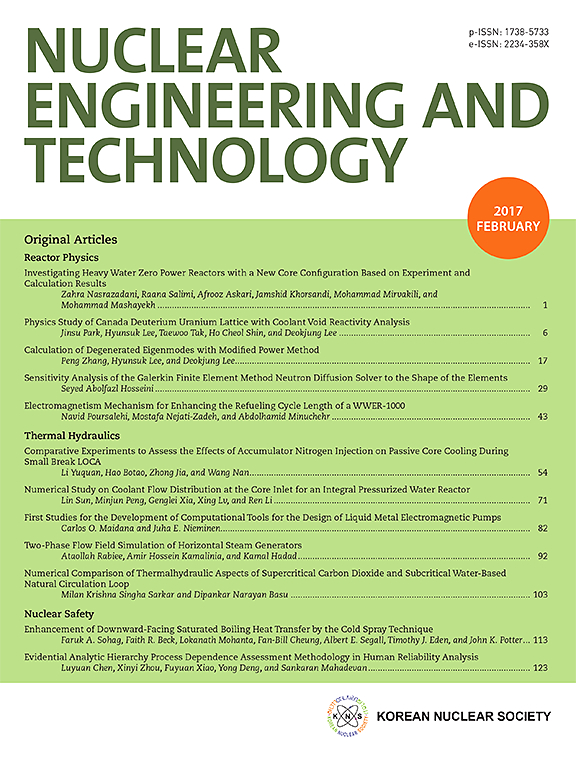Analytical solutions for thermal-hydraulic-mechanical-chemical modeling of smectite illitization in bentonite buffers for nuclear waste disposal
IF 2.6
3区 工程技术
Q1 NUCLEAR SCIENCE & TECHNOLOGY
引用次数: 0
Abstract
Nuclear waste is stored in canisters within underground repositories, surrounded by a buffer material like bentonite, which ensures isolation from the host rock due to its low hydraulic conductivity and high swelling potential. However, at high potassium ion concentrations and temperatures above 100 °C, bentonite transforms into illite, a low-swelling mineral. Many studies have addressed this phenomenon in different bentonites using numerical simulators. None has analytically modeled the phenomena of illitization and how changes in reactive surface area during drying cycles could influence the process. Furthermore, no analytical solutions address the impact of illitization and clay swelling on the transport of heat and chemical species such as K+ in diffusion-dominant or advection-dominant systems. This study develops analytical models to predict temperature, water saturation, and potassium ion concentration evolution in the bentonite buffer and their effects on the smectite-to-illite transformation process. The developed models are the first to incorporate the effects of illitization and clay swelling on the heat and species transport in an engineered barrier system under various boundary conditions. The models are based on mass and energy balance principles, validated against existing temperature solutions, experimental and numerical simulation illitization data. Preliminary validation shows that incorporating the effect of declining reactive surface area improves illitization predictions by accounting for the reduction of interlayer smectite regions, which slows the illitization process. The models are then used to simulate multi-physics behavior in a nuclear repository, and their results are compared to numerical simulations conducted using TOUGHREACT-FLAC. Porosity reduction due to both mineral transformation and swelling affects not only fluid transport but also thermal dissipation in the buffer. Under limited K+ availability, illitization becomes self-limiting, highlighting the potential buffering capacity of smectite-rich host rocks. When continuous K+ supply is modeled (e.g., via feldspar dissolution), illitization proceeds for extended durations, indicating a need to evaluate mineral assemblages and groundwater chemistry during repository design. The findings highlight the models' effectiveness in predicting the evolution of temperature, potassium ion concentration, water saturation, and smectite content in the bentonite buffer, demonstrating their utility in understanding and predicting behavior in nuclear waste repositories.
核废料处理用膨润土缓冲液中蒙脱石钝化的热-水力-机械-化学模型的解析解
核废料被储存在地下储藏库的容器中,周围是像膨润土这样的缓冲材料,由于其低水力导电性和高膨胀潜力,确保与宿主岩石隔离。然而,在高钾离子浓度和高于100°C的温度下,膨润土转化为伊利石,一种低膨胀矿物。许多研究使用数值模拟器解决了不同膨润土中的这一现象。没有人分析模拟了非钝化现象,以及干燥周期中反应表面积的变化如何影响过程。此外,没有解析解解决非石化和粘土膨胀对扩散或平流优势系统中热量和化学物质(如K+)输运的影响。本研究建立了分析模型来预测膨润土缓冲层中温度、水饱和度和钾离子浓度的演变及其对蒙脱石到伊利石转变过程的影响。所建立的模型首次考虑了在不同边界条件下,非化和粘土膨胀对工程屏障系统中热量和物种输运的影响。这些模型基于质量和能量平衡原理,并根据现有的温度解、实验和数值模拟数据进行了验证。初步验证表明,考虑到层间蒙脱石区域的减少,考虑到活性表面积下降的影响,可以改善illiization预测,从而减缓illiization过程。然后使用这些模型模拟核储存库中的多物理场行为,并将其结果与使用TOUGHREACT-FLAC进行的数值模拟进行比较。由于矿物转化和膨胀导致的孔隙度降低不仅影响流体的输送,而且影响缓冲液中的热耗散。在有限的K+可用性下,illiization成为自我限制,突出了富蒙脱石寄主岩石的潜在缓冲能力。当模拟连续的K+供应时(例如,通过长石溶解),illiization会持续更长时间,这表明在储存库设计期间需要评估矿物组合和地下水化学。研究结果强调了该模型在预测膨润土缓冲层中温度、钾离子浓度、水饱和度和蒙脱石含量演变方面的有效性,证明了其在理解和预测核废料处置库行为方面的实用性。
本文章由计算机程序翻译,如有差异,请以英文原文为准。
求助全文
约1分钟内获得全文
求助全文
来源期刊

Nuclear Engineering and Technology
工程技术-核科学技术
CiteScore
4.80
自引率
7.40%
发文量
431
审稿时长
3.5 months
期刊介绍:
Nuclear Engineering and Technology (NET), an international journal of the Korean Nuclear Society (KNS), publishes peer-reviewed papers on original research, ideas and developments in all areas of the field of nuclear science and technology. NET bimonthly publishes original articles, reviews, and technical notes. The journal is listed in the Science Citation Index Expanded (SCIE) of Thomson Reuters.
NET covers all fields for peaceful utilization of nuclear energy and radiation as follows:
1) Reactor Physics
2) Thermal Hydraulics
3) Nuclear Safety
4) Nuclear I&C
5) Nuclear Physics, Fusion, and Laser Technology
6) Nuclear Fuel Cycle and Radioactive Waste Management
7) Nuclear Fuel and Reactor Materials
8) Radiation Application
9) Radiation Protection
10) Nuclear Structural Analysis and Plant Management & Maintenance
11) Nuclear Policy, Economics, and Human Resource Development
 求助内容:
求助内容: 应助结果提醒方式:
应助结果提醒方式:


